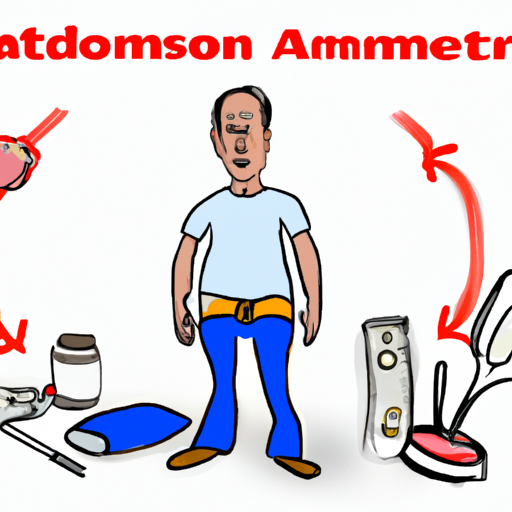Prostate adenoma, also known as benign prostatic hyperplasia (BPH), is a common condition that affects many men as they age. It can cause a range of uncomfortable symptoms and have a significant impact on a person’s quality of life. In this article, we will delve into the world of prostate adenoma, exploring its symptoms, causes, and how it is diagnosed. We will also provide a comprehensive guide to the available treatment options, both non-surgical and surgical, and discuss the importance of lifestyle changes in managing this condition. Whether you or a loved one are dealing with prostate adenoma or simply want to be well-informed, this article will serve as a valuable resource to help you understand and navigate this condition effectively.
1. Understanding Prostate Adenoma: Symptoms, Causes, and Diagnosis
Prostate adenoma, also known as benign prostatic hyperplasia (BPH), is a common condition that affects many men as they age. Understanding the symptoms, causes, and diagnosis of prostate adenoma is crucial for timely treatment and management of this condition.
Symptoms:
The symptoms of prostate adenoma can vary from mild to severe and may include urinary problems such as difficulty starting and maintaining a steady stream of urine, frequent urination (especially at night), weak urine flow, dribbling at the end of urination, and the feeling of incomplete bladder emptying. Some individuals may also experience urinary tract infections, blood in the urine, and bladder stones.
Causes:
The exact cause of prostate adenoma is not fully understood, but several factors are believed to contribute to its development. Age is a significant risk factor, with the condition being more prevalent in men over the age of 50. Hormonal changes, specifically an increase in the levels of dihydrotestosterone (DHT), a byproduct of testosterone, is also thought to play a role. Additionally, genetic factors, obesity, and certain medications may increase the likelihood of developing prostate adenoma.
Diagnosis:
To diagnose prostate adenoma, a healthcare professional will typically begin with a thorough medical history and physical examination. This may include a digital rectal examination (DRE), where the doctor inserts a gloved finger into the rectum to feel the size, shape, and texture of the prostate gland. Further diagnostic tests may be recommended, such as a prostate-specific antigen (PSA) blood test to measure the levels of PSA, a protein produced by the prostate. Elevated PSA levels may indicate prostate adenoma or other prostate conditions. Additionally, imaging tests like ultrasound, MRI, or a cystoscopy may be used to assess the size and structure of the prostate gland.
Understanding the symptoms, causes, and undergoing proper diagnosis for prostate adenoma is essential for effective treatment and management. Early detection and intervention can help prevent
2. Treatment Options for Prostate Adenoma: A Comprehensive Guide
Treatment Options for Prostate Adenoma: A Comprehensive Guide
Prostate adenoma, also known as benign prostatic hyperplasia (BPH), is a condition that affects many men as they age. It occurs when the prostate gland, which is located below the bladder, enlarges and causes urinary symptoms. While it is not a life-threatening condition, it can significantly impact a man’s quality of life. Fortunately, there are several treatment options available for prostate adenoma, ranging from lifestyle changes to surgical interventions. In this comprehensive guide, we will explore the various treatment options to help you make an informed decision about managing your condition.
1. Watchful Waiting:
For men with mild symptoms or those who are not bothered by their symptoms, watchful waiting may be an appropriate approach. This involves regular monitoring of the condition without immediate intervention. Your doctor will closely monitor any changes in symptoms or the size of the prostate gland through regular check-ups and follow-ups. Watchful waiting is typically recommended for older men who have minimal symptoms and are not at risk of complications.
2. Lifestyle Modifications:
In some cases, lifestyle modifications alone can alleviate the symptoms associated with prostate adenoma. These modifications may include:
a. Fluid Management: Limiting the intake of fluids, especially before bedtime, can help reduce the frequency of nighttime urination.
b. Bladder Training: This involves consciously delaying urination when the urge arises and gradually increasing the time between urinations. Bladder training helps to improve bladder control and reduce urgency.
c. Dietary Changes: Avoiding or limiting the consumption of caffeine, alcohol, and spicy foods, which can irritate the bladder, may provide relief from urinary symptoms.
d. Physical Activity: Engaging in regular exercise, such as walking or swimming, can help improve overall health and reduce urinary symptoms.
3. Medications:
Several medications are available to manage the symptoms of prostate adenoma. These medications work in different ways to either shrink the prostate gland or relax the muscles
3. Managing Prostate Adenoma: Lifestyle Changes and Surgical Interventions
Managing Prostate Adenoma: Lifestyle Changes and Surgical Interventions
Prostate adenoma, also known as benign prostatic hyperplasia (BPH), is a common condition that affects many men as they age. While the exact cause of prostate adenoma is not fully understood, it is believed to be influenced by hormonal imbalances and age-related changes in the prostate gland. The condition can result in bothersome symptoms such as frequent urination, weak urine flow, and difficulty emptying the bladder completely.
When it comes to managing prostate adenoma, there are several approaches that can be adopted depending on the severity of the symptoms and the impact on an individual’s quality of life. Lifestyle changes and surgical interventions are two main avenues that can be explored for effective management.
Lifestyle Changes
1. Diet Modifications: Making changes to your diet can help alleviate symptoms associated with prostate adenoma. Consuming a diet rich in fruits, vegetables, and whole grains while limiting the intake of red meat and processed foods may be beneficial. Additionally, reducing caffeine and alcohol consumption can help minimize urinary symptoms.
2. Fluid Management: Managing fluid intake can help control the frequency of urination. It is recommended to avoid excessive fluid consumption, especially before bedtime, to prevent nocturia (waking up frequently at night to urinate).
3. Regular Exercise: Engaging in regular physical activity can have a positive impact on prostate health. Exercise helps maintain a healthy weight, improves overall cardiovascular health, and may potentially reduce the risk of prostate adenoma progression.
4. Bladder Training: Training the bladder can help improve urinary control and reduce the urgency to urinate. Techniques such as delaying urination and gradually increasing the time between bathroom visits can be effective.
Surgical Interventions
1. Transurethral Resection of the Prostate (TURP): TURP is a common surgical procedure used to treat prostate adenoma. It involves removing excess tissue from the prostate gland to relieve urinary


